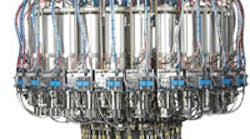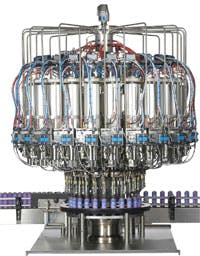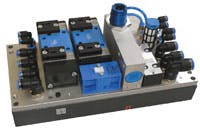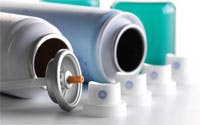Oystar Aerofill, Bury St. Edmunds, Suffolk, UK, is a leading manufacturer of aerosol filling and closing equipment. Company officials were looking for ways to substantially reduce the amount of time it takes to assemble machines, which are built to customer specifications.
To achieve this goal, designers at Oystar Aerofill have adopted Festo’s integrated multi-layer duct plate technology for the pneumatic logic and control functions of its latest-generation machines. Company officials estimate that switching to this modular, fully-integrated form of pneumatic valve block, has slashed 30% from the average time it takes to build a system.
Oystar Aerofill has more than 50 years’ experience in the design and production of aerosol filling and closing equipment. The company works with many of the world’s major aerosol manufacturers and produces an extensive range of equipment for processing aerosols containing products as diverse as hair spray, deodorant, paint, air freshener, and insecticide. Oystar Aerofill’s expertise covers every industry requirement, from semiautomated, stand-alone machines to complete flexible manufacturing systems.
Every machine that Oystar Aerofill produces is manufactured to specifications and, if necessary, can be supplied as a fully compliant unit for use in the propellant gas filling area of aerosol production. The company offers three families of products for use on index lines — two are pneumatically driven, and the other uses electrical servos — together with a family of fully-automated, high speed rotary filling and closing machines for use on continuous motion lines.
Index lines are used primarily by manufacturers that need to handle a wide variety of different types of aerosols produced in relatively small batches. These types of production lines essentially operate on a stopstart basis. Each aerosol can, or small group of cans, is moved by a conveyor to successive processing stages, and progression of the line is then halted until that particular process has been completed. The process stage can range from a single function, such as filling, to more complex multifunctional tasks, such as valve insertion, crimping, and gas filling.
Two philosophies of filling
Although index lines tend to have a relatively low throughput — the fastest machine that Oystar Aerofill produces for these types of production lines can handle 160 cans/min — they offer flexibility. Changing over production from one type of aerosol can to another is accomplished easily and quickly. Another advantage of index lines is that they are relatively compact, whereas continuous motion lines tend to take up a lot of space on the production floor.
Continuous motion production lines are used whenever high throughput is paramount. Therefore, they tend to be used by high-volume manufacturers. Aerosol manufacturing is dominated by a handful of industry leaders — 80% of the world’s aerosol production is handled by just 20% of the world’s aerosol manufacturers. Most of these companies use continuous motion production lines.
The types of aerosol filling and closing machines used on continuous flow production lines tend to be larger than those designed for use on index lines, and each machine on the line is usually dedicated to performing one specific function. The machines also feature far more sophisticated automation. They are designed for continuous, high-speed operation, and Oystar Aerofill’s Rotary Pak family of continuous motion aerosol filling and closing machines are a case in point. The latest generation of these machines can handle up to 500 cans/min.
Modularity for flexibility
Although every Oystar Aerofill machine is designed to suit the customer’s specific product filling, valve insertion, crimping, or propellant filling requirements, many basic functions are broadly similar across each product range. The working heads are modular units, enabling the machines to be readily modified to accommodate different production needs. Each working head is backed by a manifold containing the necessary control valves for its pneumatic actuators and associated components. Until recently, Oystar Aerofill produced these manifolds in-house from drilled aluminium blocks, and subsequently, had to assemble all the necessary adapter plates, valves, and tubing. This approach demanded considerable skilled labor — tying up production capacity — and led to high process costs and lengthy machine build times.
In search of a solution, Oystar Aerofill officials approached Festo Ltd., to investigate whether standard pre-built manifolds could provide a technically viable and more cost-effective alternative. According to John Blake, Festo’s business development consultant, “This application was an obvious contender for our integrated pneumatic duct plate technology. It uses a multi-layer polymer manifold block with fully integrated pneumatic logic to provide a standardized module. This approach means that we can guarantee the repeatability of each machine head, which had been difficult because manual alignment was required.
“So far, we have developed three different modules, which can be integrated in a variety of combinations to cover a wide range of Oystar Aerofill’s machines,” Blake concludes. The modular approach also allows individual features to be included or omitted without the need for a complete redesign. Blake adds, “This type of integration technology helps reduce both the physical size of the modules and the number of interfaces that are needed, which simplifies installation and maintenance significantly.”
David Routley, Oystar Aerofill’s managing director, agrees with this assessment. “Festo’s integrated duct plate technology has really come up trumps for this application. The project involved a high degree of teamwork, and the collaboration certainly paid off — Festo met our brief by making the modules 100% interchangeable with our previous versions, but they are much easier to install and maintain.”
The new manifolds require much less tubing and reduce the number of connections that need to be made. The connections that still are made use simple push-fit connectors. All told, the improvements significantly increase machine accessibility, which, therefore, simplifies servicing and maintenance.
Although the purchase cost of Festo’s solution is slightly higher than Oystar Aerofill’s previous in-house approach, the purchasing process is much simpler, and the company can now order a complete ATEX-compliant control module under a single part number. But the largest gain undoubtedly is in time-to-build reduction. Oyster Aerofill has been able to reduce machine assembly time by an average of 30%, which obviously conveys major cost benefits.
Information for this article was provided by Nicola Meadway, of Festo Ltd., Fleet, Hampshire, UK. She can be contacted at [email protected]. For more information, visit www.festo.com.
|
Hungering for more? For more info about pneumatic valves, just click on the Pneumatic Valves Technology Zone on our home page, at www.hydraulicspneumatics.com. When you do, you’ll be shown links to archived articles discussing air valves, tutorial chapters on air valves form our Fluid Power Basics section, capsule descriptions of new products, a list of featured suppliers of air valves, and a link to our Designer’s Guide charts, which provide product specifications and company information in an easy-to-read graphical format. |




